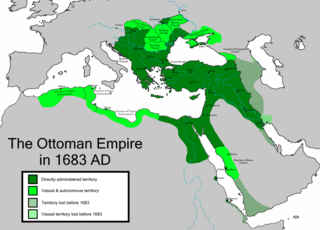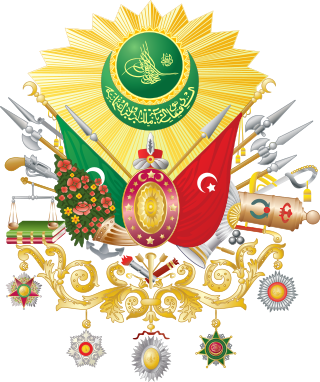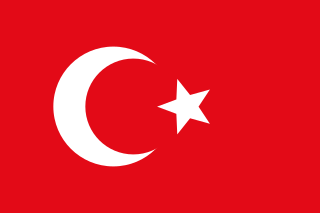The roots of traditional music in Turkey span across centuries to a time when the Seljuk Turks migrated to Anatolia and Persia in the 11th century and contains elements of both Turkic and pre-Turkic influences. Much of its modern popular music can trace its roots to the emergence in the early 1930s drive for Westernization.

The Sublime Porte, also known as the Ottoman Porte or High Porte, was a synecdoche or metaphor used to refer collectively to the central government of the Ottoman Empire in Istanbul.

Rūm, also romanized as Roum, is a derivative of Parthian (frwm) terms, ultimately derived from Greek Ῥωμαῖοι. Both terms are endonyms of the pre-Islamic inhabitants of Anatolia, the Middle East and the Balkans and date to when those regions were parts of the Eastern Roman Empire.

Khedive was an honorific title of Classical Persian origin used for the sultans and grand viziers of the Ottoman Empire, but most famously for the viceroy of Egypt from 1805 to 1914.
In music, heterophony is a type of texture characterized by the simultaneous variation of a single melodic line. Such a texture can be regarded as a kind of complex monophony in which there is only one basic melody, but realized at the same time in multiple voices, each of which plays the melody differently, either in a different rhythm or tempo, or with various embellishments and elaborations. The term was initially introduced into systematic musicology to denote a subcategory of polyphonic music, though is now regarded as a textural category in its own right.

A seraglio, serail, seray or saray is a castle, palace or government building which was considered to have particular administrative importance in various parts of the former Ottoman Empire.
North Africa has contributed considerably to popular music, especially Egyptian classical music alongside el Gil, Algerian raï and Chaabi. The broad region is sometimes called Maghreb, and the term Maghrebian music is in use. For a variety of reasons Libya does not have as extensive nor popular a tradition as its neighbours. Folk music abounds, however, despite frequent condemnation and suppression from governments, existing in multiple forms across the region—the Berbers, Sephardic Jews, Tuaregs, Copts and Nubians, for example, retain musical traditions with their ancient roots.

Ottoman Turkish was the standardized register of the Turkish language in the Ottoman Empire. It borrowed extensively, in all aspects, from Arabic and Persian. It was written in the Ottoman Turkish alphabet. Ottoman Turkish was largely unintelligible to the less-educated lower-class and to rural Turks, who continued to use kaba Türkçe, which used far fewer foreign loanwords and is the basis of the modern standard. The Tanzimât era (1839–1876) saw the application of the term "Ottoman" when referring to the language ; Modern Turkish uses the same terms when referring to the language of that era. More generically, the Turkish language was called تركچه Türkçe or تركی Türkî "Turkish".
The Turkish makam is a system of melody types used in Turkish classical music and Turkish folk music. It provides a complex set of rules for composing and performance. Each makam specifies a unique intervalic structure and melodic development (seyir). Whether a fixed composition or a spontaneous composition, all attempt to follow the melody type. The rhythmic counterpart of makam in Turkish music is usul.
Tunisia is a North African country with a predominantly Arabic-speaking population. The country is best known for malouf, a kind of music imported from Andalusia after the Moors expulsion in the 15th century. Though in its modern form, malouf is likely very dissimilar to any music played more than four centuries ago, it does have its roots in Spain and Portugal, and is closely related to genres with a similar history throughout North Africa, including malouf's Libyan cousin, Algerian gharnati and Moroccan ala or Andalusi. During the Ottoman era, malouf was influenced by Turkish music. However, Tunisian repertoires, styles and also instruments remain distinctive – the ʻūd tūnsī is an emblematic case. This is a close relative of the 'uds associated with Algeria and also Morocco.

Ottoman music or Turkish classical music is the tradition of classical music originating in the Ottoman Empire. Developed in the palace, major Ottoman cities, and Sufi lodges, it traditionally features a solo singer with a small to medium-sized instrumental ensemble.

Islamic culture or Muslim culture refers to the historic cultural practices that developed among the various peoples living in the Muslim world. These practices, while not always religious in nature, are generally influenced by aspects of Islam, particularly due to the religion serving as an effective conduit for the inter-mingling of people from different ethnic/national backgrounds in a way that enabled their cultures to come together on the basis of a common Muslim identity. The earliest forms of Muslim culture, from the Rashidun Caliphate to the Umayyad Caliphate and the early Abbasid Caliphate, was predominantly based on the existing cultural practices of the Arabs, the Byzantines, and the Persians. However, as the Islamic empires expanded rapidly, Muslim culture was further influenced and assimilated much from the Iranic, South Asian, Caucasian, Turkic, Malay, Somali, Berber, and Indonesian cultures.

A Sufi lodge is a building designed specifically for gatherings of a Sufi brotherhood or tariqa and is a place for spiritual practice and religious education. They include structures also known as khānaqāh, zāwiya, ribāṭ, dargāh and takya depending on the region, language and period. In Shia Islam, the Husayniyya has a similar function.
Peşrev or Peshrev is an instrumental form in Ottoman music. It is the name of the first piece of music played during a group performance called a fasıl. It also serves as the penultimate piece of the Mevlevi ayini, a ritual music of the Mevlevi Order, under the name son peşrev, preceding son semai. It usually uses long rhythm cycles, stretching over many measures as opposed to the simpler usul the other major form of instrumental music uses, saz semai.
Kouloughlis, also spelled Koulouglis, Cologhlis and Qulaughlis was a term used during the period of Ottoman influence in North Africa that usually designated the mixed offspring of Ottoman officials and janissaries, and local North African women.
The fasıl is a suite in Ottoman classical music. It is similar to the Arabic nawba and waslah.
The saz semai is an instrumental form in Ottoman classical music. It was typically the closing movement of a fasıl. The saz semai is metered and typically uses the usul called aksak semai.

Ottoman Syria is a historiographical term used to describe the group of divisions of the Ottoman Empire within the region of Levant, usually defined as being east of the Mediterranean Sea, west of the Euphrates River, north of the Arabian Desert and south of the Taurus Mountains.

Syria is a historical region located east of the Mediterranean Sea in West Asia, broadly synonymous with the Levant. Other synonyms are Greater Syria or Syria-Palestine. The region boundaries have changed throughout history. However, in modern times, the term "Syria" alone is used to refer to the Syrian Arab Republic.









